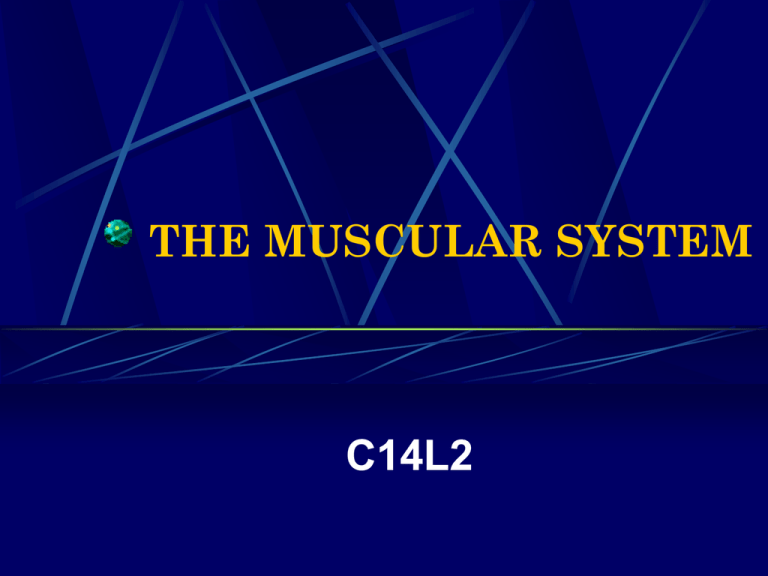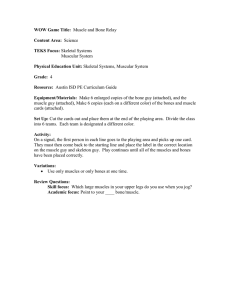THE MUSCULAR SYSTEM C14L2
advertisement

THE MUSCULAR SYSTEM C14L2 How do bones, muscles, and skin help maintain the body’s homeostasis? The Muscular System • What does the muscular system do? • How do types of muscle differ? • How does the muscular system interact with other body systems? Muscular System Stats There are approximately 600 muscles. Of all the many different kinds of cells in the human body, only muscle cells have the ability to shorten (contract) and return to their original length (relax). Functions of muscles movement stability protection maintain body temperature helps digestion and respiration Movement Bones move when muscles contract. Tendons attach muscles to bones and help keep joints in place when your body moves. The two key words that describe the muscular system are contraction and movement. Contraction refers to the ability of a muscle tissue to shorten and thereby cause movement. Your muscles can move your body only by pulling, never by pushing. Stability Your muscles pull in different directions to help you keep your balance. Protection Muscles protect your body by covering most of your skeleton and most of the organs inside your body like a layer of padding. Maintain Body Temperature • Shivering occurs when muscles contract rapidly and change chemical energy to thermal energy, thereby raising your body’s temperature. • Muscles also change chemical energy to thermal energy during exercise. Helps Digestion & Respiration There are many muscles in your body that are not attached to bones. The contraction of these muscles cause blood and food to move throughout your body. Muscle Nervous Control Some muscles you consciously control, and others you can't. voluntary - a muscle that can be controlled at will (you consciously control) involuntary - muscles controlled automatically by the brain; controlled without conscious effort Types of muscle tissue (distinguished by their location, microscopic appearance, and type of nervous control) Skeletal Muscle Visceral Muscle Cardiac Muscle Skeletal Muscle named for its location (usually attached to skeleton) striated (dark and light stripes in its cells)appearance voluntary (controlled by conscious thought) Skeletal Muscle Skeletal muscles move bones by pulling them and working in pairs. Skeletal Muscle Skeletal muscles move bones by pulling them and working in pairs. Skeletal Muscle • Your skeletal muscles can change throughout your lifetime. • Exercise allows muscle cells to increase in size, making the entire muscle larger and stronger. Visceral Muscle location: walls of internal organs, iris of the eye, sphincters appearance: nonstriated or smooth (shorter, one nucleus, arranged loosely) nervous control: involuntary (not directly controlled by conscious thought) Visceral Muscle the term visceral refers to internal organs the name fits well because visceral muscles is located in the walls of internal organs such as the stomach, intestines, blood vessels, and urinary bladder visceral muscle is also located in the iris of the eye most of the sphincters (circular bundles of muscles that regulate the diameter of various tubular organs and openings) are visceral muscles; the muscular valves at both ends of the stomach are examples of sphincters Visceral Muscle Contraction of smooth muscles helps move material through the body, such as food in the stomach and blood through the vessels Cardiac Muscle location: only in heart appearance: striated (striations are not as regular and distinct as skeletal; muscle fibers are branched and joined together) nervous control: involuntary Cardiac Muscle • When cardiac muscles contract and relax, they pump blood through your heart and through vessels throughout your body. • Cardiac cells send signals to other cardiac cells so that they all contract at the same time.






